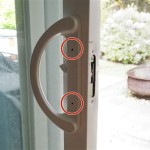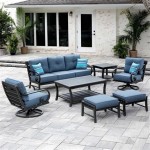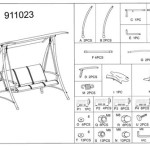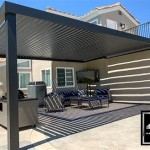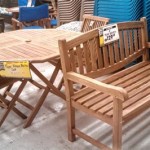Best Outdoor Furniture for Uncovered Patios
Selecting the right outdoor furniture for an uncovered patio presents unique challenges. Unlike covered spaces, uncovered patios expose furniture to the full brunt of the elements: intense sunlight, rain, wind, and fluctuating temperatures. This exposure necessitates careful consideration of materials, construction, and design to ensure longevity and maintain aesthetic appeal. This article explores key factors in choosing optimal outdoor furniture for uncovered patios, providing guidance on material selection, weather resistance, style considerations, and maintenance protocols.
Understanding the Environmental Challenges
Before selecting outdoor furniture, understanding the specific environmental challenges of an uncovered patio is crucial. Direct sunlight can cause fading, cracking, and warping in certain materials. Rain can lead to mildew, rust, and water damage. High winds can topple lightweight furniture, posing a safety risk and potentially causing damage. Temperature fluctuations, especially in regions with distinct seasons, can stress materials, leading to premature wear and tear. Therefore, furniture chosen for uncovered patios must be specifically designed to withstand these harsh conditions.
The ultraviolet (UV) radiation from sunlight is a significant concern. UV rays break down chemical bonds in many materials, leading to color fading and structural weakening. Some plastics become brittle and crack, while fabrics lose their vibrant colors and become susceptible to tearing. Metal can corrode and rust, while wood can dry out, crack, and warp. Understanding the UV resistance of different materials is paramount for maximizing the lifespan of outdoor furniture.
Moisture is another major challenge. Rainwater can penetrate porous materials, leading to mold and mildew growth. Metal furniture is susceptible to rust, which can weaken the structure and detract from its appearance. Wood can rot if not properly treated and maintained. Even materials marketed as water-resistant may still require regular cleaning and sealing to prevent water damage.
Wind resistance is also a critical factor, especially in areas prone to strong gusts. Light and flimsy furniture can be easily blown over, causing damage to the furniture itself and potentially to surrounding structures or landscaping. Choosing heavier pieces or securing furniture with tethers or weights can mitigate this risk.
Materials That Endure the Elements
The choice of materials is the most critical factor in determining the suitability of outdoor furniture for an uncovered patio. Certain materials are inherently more resistant to the elements than others, offering superior durability and longevity.
Teak: Teak is a hardwood renowned for its exceptional weather resistance. Its high oil content naturally repels water, preventing rot and decay. Teak is also resistant to insects and fungi. While teak furniture can be expensive, its longevity and minimal maintenance requirements make it a worthwhile investment for uncovered patios. Over time, untreated teak will weather to a beautiful silver-gray patina, which many find aesthetically pleasing. However, the original color can be maintained with regular cleaning and oiling.
Powder-Coated Aluminum: Aluminum is a lightweight yet strong metal that is naturally rust-resistant. Powder coating provides an additional layer of protection against the elements, preventing corrosion and chipping. Powder-coated aluminum furniture is available in a wide range of styles and colors, making it a versatile option for any patio design. It is also relatively easy to clean and maintain, requiring only occasional washing with soap and water.
Wrought Iron: Wrought iron is a durable and heavy material that can withstand strong winds and heavy rain. It is often treated with a protective coating to prevent rust. Wrought iron furniture typically has a classic and elegant aesthetic, making it a popular choice for traditional outdoor spaces. However, wrought iron can be uncomfortable to sit on without cushions and can become hot in direct sunlight. Regular maintenance, including cleaning and occasional repainting, is necessary to prevent rust.
Synthetic Resin Wicker: Synthetic resin wicker is a durable and weather-resistant alternative to natural wicker. It is made from polyethylene or PVC, which are resistant to water, UV radiation, and mildew. Synthetic resin wicker furniture is available in a variety of styles and colors, and it is relatively easy to clean and maintain. It is also lightweight, making it easy to move around the patio. However, lower-quality synthetic resin wicker can become brittle and crack over time, so it is important to choose a reputable brand.
Outdoor Fabrics: The choice of fabric for cushions and upholstery is also crucial. Outdoor fabrics are specifically designed to resist fading, water damage, and mildew. Acrylic fabrics, such as Sunbrella, are a popular choice for outdoor furniture due to their excellent UV resistance, stain resistance, and water repellency. Olefin fabrics are another durable and affordable option. It is important to choose fabrics that are easy to clean and maintain, and that can withstand prolonged exposure to the elements.
Design Considerations for Uncovered Spaces
Beyond material selection, design considerations play a vital role in the functionality and aesthetics of outdoor furniture for uncovered patios. The overall style, size, and layout of the furniture should complement the patio's architecture and landscaping, while also catering to the specific needs and preferences of the users.
Style and Aesthetics: The style of outdoor furniture should reflect the overall design aesthetic of the home and patio. Contemporary designs often feature clean lines and minimalist silhouettes, while traditional designs incorporate more intricate details and ornate embellishments. Consider the color palette of the patio and choose furniture that complements the existing scheme. Neutral colors, such as gray, beige, and white, are versatile and can be easily accessorized with colorful cushions and throws.
Size and Scale: The size of the furniture should be proportionate to the size of the patio. Overly large furniture can overwhelm a small space, while undersized furniture can look dwarfed in a large space. Measure the patio carefully and plan the layout before purchasing furniture. Consider the number of people who will typically use the patio and choose furniture that can comfortably accommodate them. Also consider storage options for cushions and covers when the furniture is not in use.
Comfort and Functionality: Outdoor furniture should be comfortable and functional, providing a relaxing and enjoyable outdoor experience. Choose chairs and sofas with comfortable cushions and supportive frames. Consider adding accessories such as outdoor rugs, pillows, and throws to enhance comfort and create a cozy atmosphere. Think about the primary use of the patio. Is it for dining, lounging, or entertaining? Choose furniture that is appropriate for the intended purpose.
Storage and Portability: Depending on the climate and the time of year, it may be necessary to store outdoor furniture during periods of inclement weather. Choose furniture that is easy to move and store, or invest in protective covers to shield it from the elements. Lightweight furniture is easier to move, but it may not be as stable in windy conditions. Consider the trade-offs between portability and stability when making your selection.
Accessorizing the Space: Accessories can significantly enhance the look and feel of an uncovered patio. Outdoor rugs can define seating areas and add warmth and texture. Planters can bring greenery and color to the space. Outdoor lighting can create a welcoming ambiance in the evening. Choose accessories that are weather-resistant and durable, and that complement the overall design aesthetic of the patio.
Maintaining Outdoor Furniture
Regardless of the materials chosen, regular maintenance is essential for prolonging the life of outdoor furniture and maintaining its appearance. Proper cleaning, protection, and storage practices can prevent damage from the elements and ensure that the furniture remains in good condition for years to come.
Regular Cleaning: Clean outdoor furniture regularly to remove dirt, dust, and debris. Use a mild soap and water solution and a soft brush or cloth. Avoid using harsh chemicals or abrasive cleaners, as these can damage the finish. Rinse the furniture thoroughly with water and allow it to dry completely before storing it or covering it. For specific materials, consult the manufacturer's instructions for cleaning recommendations.
Protecting from the Elements: When not in use, protect outdoor furniture from the elements with covers or by storing it in a shed or garage. Protective covers should be made of breathable material to prevent moisture buildup. Ensure that the furniture is clean and dry before covering it to prevent mildew growth. If storing furniture indoors, clean it thoroughly and allow it to dry completely before storing it.
Addressing Specific Material Needs: Different materials require different maintenance approaches. Teak furniture can be oiled periodically to maintain its original color, but it can also be left to weather naturally to a silver-gray patina. Powder-coated aluminum furniture can be cleaned with soap and water. Wrought iron furniture should be inspected regularly for rust and repainted as needed. Synthetic resin wicker furniture can be cleaned with soap and water. Outdoor fabrics should be cleaned according to the manufacturer's instructions.
Winter Storage: In regions with cold winters, it is essential to properly store outdoor furniture to protect it from freezing temperatures, snow, and ice. Clean the furniture thoroughly, allow it to dry completely, and store it in a dry, sheltered location. Cover the furniture with breathable covers to protect it from dust and debris. If space is limited, stack chairs and tables to maximize storage space.
By carefully considering the environmental challenges, choosing durable materials, incorporating thoughtful design elements, and implementing proper maintenance practices, individuals can select outdoor furniture that will thrive on an uncovered patio, providing years of enjoyment and enhancing the beauty of the outdoor living space.

The Best Patio Furniture And How To Shop For It Reviews By Wirecutter

The Best Patio Furniture And How To Shop For It Reviews By Wirecutter

The Best Patio Furniture And How To Shop For It Reviews By Wirecutter

The Best Patio Furniture And How To Shop For It Reviews By Wirecutter

Patio Furniture Buying Guide The Home

Patio Furniture Buying Guide The Home

40 Small Patio Ideas To Create A Cozy Outdoor Space

40 Small Patio Ideas To Create A Cozy Outdoor Space

Best Material For Outdoor Furniture Covers Oakville Home Leisure

How To Choose Outdoor Furniture

